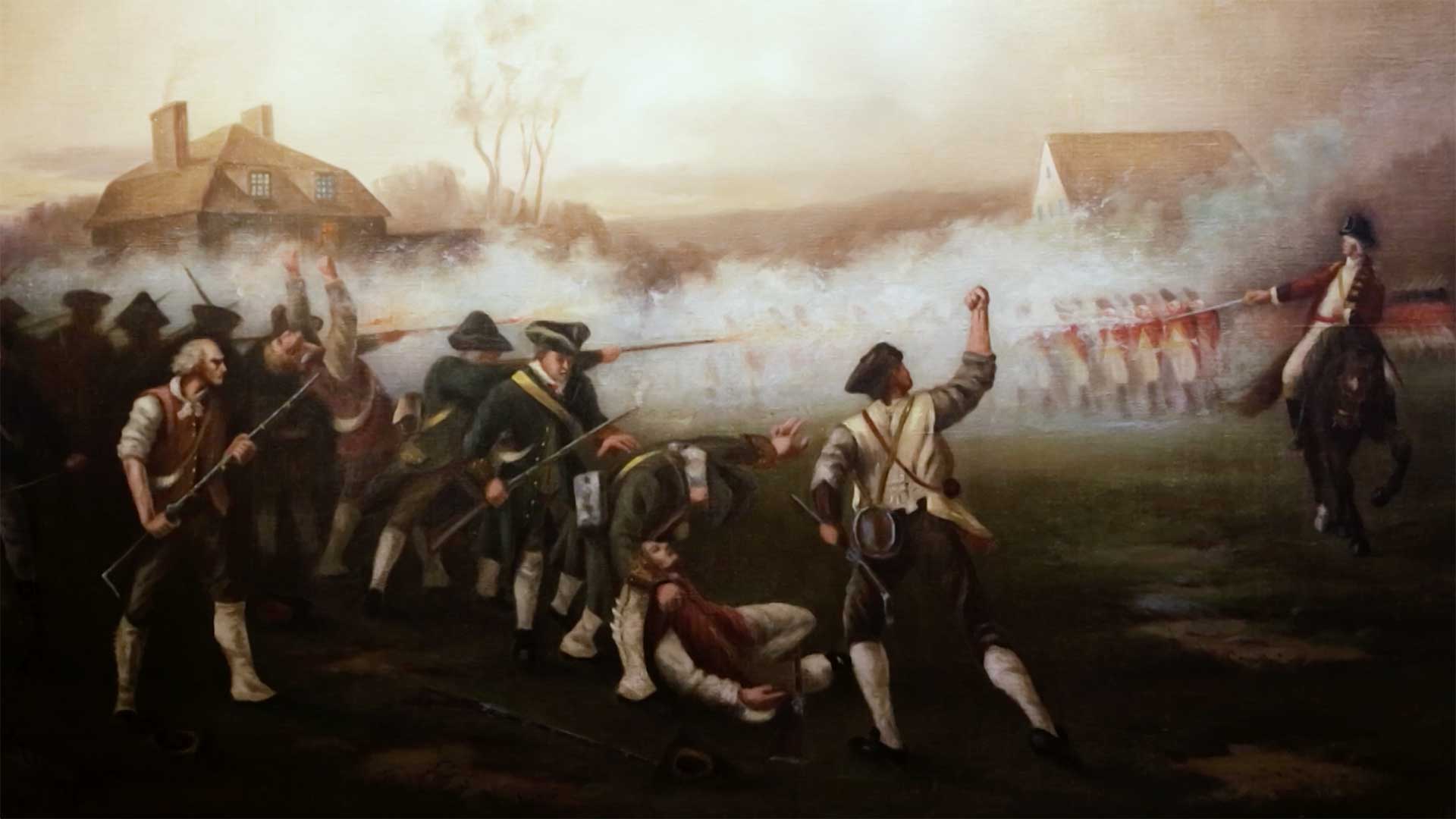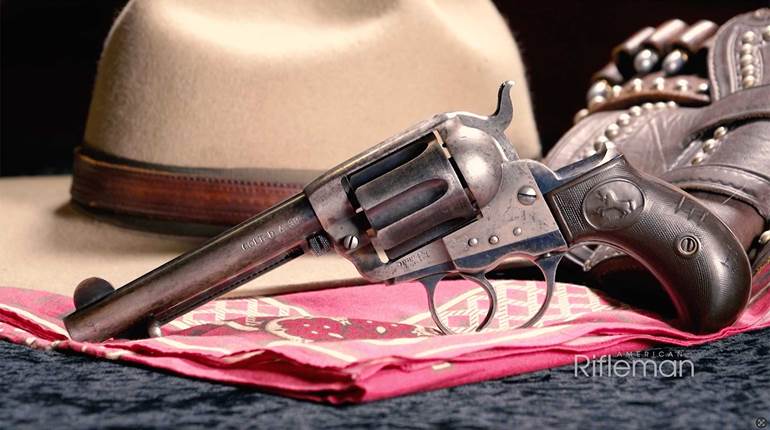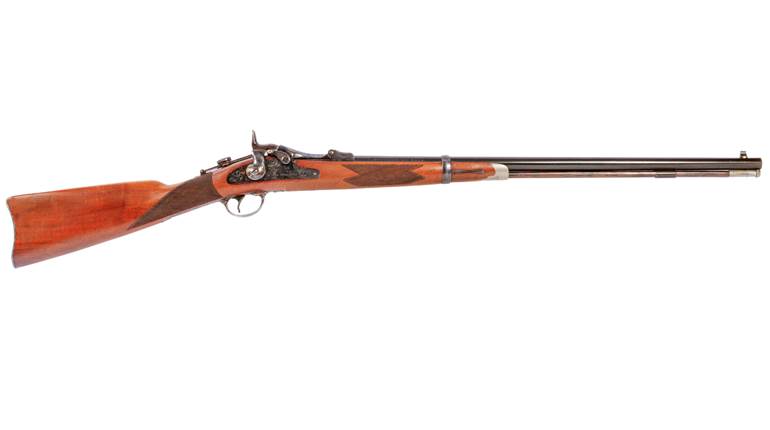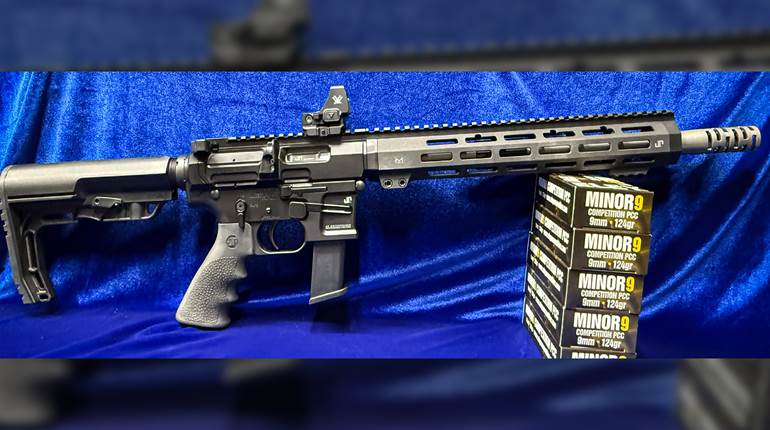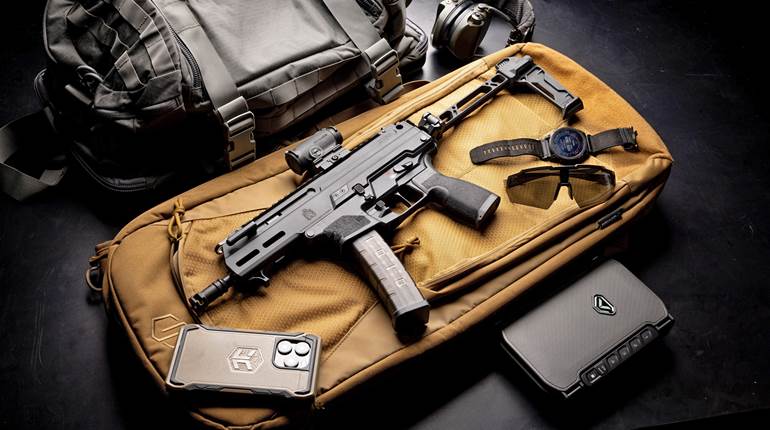
This article by Colonel E. H. Harrison originally appeared in the August 1949 issue of The American Rifleman. To subscribe to the magazine, visit the NRA Membership page.

The double-barreled gun assumed its present general form about a hundred and fifty years ago in the classic pieces made by the celebrated Joseph Manton and other London gunmakers. In exterior form, caliber, weight, balance, stocking, and manner of use, the double gun of today does not differ essentially from the London gun of that time. No other firearm has shown such stability of form.
There has been, however, a long evolution of firing locks and breechloading mechanisms leading up to those of today. The owner of a double gun, whatever its age or country of origin, can find in it the impress of many slow advances worked out first by individual makers and then adopted by all of them. Even now this is so: from Vienna to New England all double guns are basically alike.
 Fig. 1: The earliest and simplest type of double-gun bolting mechanism, a turn button which made engagement with a ridge beneath the breech end of the barrels, was standardized by C. Lefaucheux, a Parisian gunmaker.
Fig. 1: The earliest and simplest type of double-gun bolting mechanism, a turn button which made engagement with a ridge beneath the breech end of the barrels, was standardized by C. Lefaucheux, a Parisian gunmaker.
The breechloading double rests on a single fundamental device, the hinged action. Like almost all fundamental inventions in arms, it originated in Europe. While the hinged action had been used sporadically in German breechloaders for two hundred years, it was systematized by C. Lefaucheux, a Paris gunmaker, about 1836. He was the man whose name has become attached to the pinfire cartridge.
The Lefaucheux gun was simplicity itself. Figure 1 shows the earliest Lefaucheux type of bolting. The bolt which fa tens the gun closed is nothing but a turnbutton engaging a lump on the bottom of the barrels near the breech, forming the so-called 'double grip.' The bolt is turned for release by swinging to the right an under-lever which lies beneath the fore-end. The cocks, or hammers as they are now called, were arranged to strike downward rather than forward, since the pins from the cartridges projected straight up.
It will be noticed that the barrels are hinged to the front end of the action body, and they are bolted down to that portion of the body lying beneath the barrels, which is called the bar. The earlier guns of Lefaucheux type gave trouble by a stretching and bending of the bar, permitting the barrels to droop. When this was corrected by strengthening the bar, the breechloader was considered acceptable, and by 1855 it was in wide use in England and Europe.
The pinfire cartridges, while looking very dangerous nowadays, were not considered so at that time and were even carried loose in the pocket. But in 1861 the first center-fire double gun was put on the market by a London maker named Daw. Some practical men objected to center-fire ammunition because it required that the gun be complicated by an extractor, while the pinfire gun had no such frill and the gunner pulled out the empties by the pins! But these stalwarts were soon overruled, and the pinfire passed out of use except on the French countryside where it can be seen to this day.
 Fig. 2: The double under-bolt by Purdey is found on many foreign guns, but it is not used on any of American manufacture.
Fig. 2: The double under-bolt by Purdey is found on many foreign guns, but it is not used on any of American manufacture.
When the hinged action and center-fire ammunition became commonplace, the double gun entered a long period of improvement and refinement. The 1860's saw many famous names—Purdey, Rigby, Greener, etc.—already long in existence. Prompted by social conditions of the time, these and other makers continually strove to make the mechanical parts of the gun equal in elegance and refinement to the gun itself. Efforts were centered on both lock* and bolting arrangement.
While the primitive bolt of Figure 1 continued in use for a long time, it was not completely satisfactory and a variety of others were invented. By far the most important was the Purdey double under-bolt. Shown in Figure 2, it is a flat piece lying within the bar and engaging large notches in two tandem lumps beneath the barrels. The appearance of these notches is so familiar that they are not illustrated in detail. Hardly an English or European gun can be found without this bolt; on the other hand, not a single American gun uses it, though some do use a single under-bolt.
The double under-bolt made possible for the first time a characteristic feature of the modern double gun—the snap action, which bolts itself automatically when the barrels are closed. Here automatic bolting is accomplished simply by a spring pushing the under-bolt forward into the notches as soon as the notches come down into line.
Several means were devised to draw the under-bolt to the rear for disengagement. Popular for a long time was the under-lever, fitting below the trigger guard and dropping down in the same way as the lever of a Farquharson action. It was arranged to start the bolt rearward by a prying action, and the mechanical advantage made it especially suitable to very heavy guns and rifles in which the weight of the barrels and the forces of discharge tend to stick a tightly fitted under-bolt. Sometimes the external part of the lever was bent to the right and upward, resulting in the side-lever action. Representative of this action is the double-barreled pistol illustrated in Figure 3.
 Fig. 3: The side-lever action is a variation of the under-lever developed by bending the under-lever to the right and upward to lie along stock.
Fig. 3: The side-lever action is a variation of the under-lever developed by bending the under-lever to the right and upward to lie along stock.
The familiar top-lever action was first brought out by Westley Richards. It was accepted at once and is now universal. though side-lever and under-lever guns continued to be made in small numbers until recently.
The first hammerless gun lock was put on the market by Daw in 1862, after he had prepared the way with his centerfire doubles of the preceding year. In Daw's gun, cocking", as done by the first movement of the under-lever. Several others made guns on the same system, but the hammerless gun did not become popular until Needham in 1871 arranged the cocking apparatus to be operated by opening the barrels, the weight and leverage of the barrels making the operation very easy. A final improvement was made by Anson and Deeley, who in 1875 introduced the construction of cams in the rear face of the fore-end to operate the cocking levers.
When the outside hammers were eliminated and the inside tumblers made to serve as hammers, the locks remained mounted on side-plates. There are two types of sidelocks, called back-action and bar-action depending on whether the mainspring lies to the rear or forward in the bar. These two types are shown schematically in Figures 4 and 5, in which the sears and other parts are omitted for clearness.
A striking modification was the so-called boxlock, invented in 1876 by Anson and Deeley. In this type the hammers are simply carried in slots milled in the solid metal of the breech, in the position shown in Figure 6. There is no simpler or more compact lock in any firearm. Most English and European makers have adopted it for all except their most expensive models, and Greener and Westley Richards use it exclusively. Every American double, with the single exception of the L. C. Smith, is made on some variation of the boxlock.
 Fig. 4: Schematic drawing of back-action lock shows that it must be hollowed out at the rear to make room for the mainspring.
Fig. 4: Schematic drawing of back-action lock shows that it must be hollowed out at the rear to make room for the mainspring.
The forces in a gun during firing act to separate the barrels and breech, and also to rotate the barrels about the hinge. An under-bolt does not fasten the barrels to the breech, but only secures them to the bar. Therefore the tightness of an under-bolted gun depends entirely on the strength of the bar.
Note that with the back-action hammerless lock in Figure 4 the bar must be hollowed out enough to take the cocking levers as well as the under-bolt. With the bar-action lock, the bar must contain those parts and the mainsprings also, as can be seen in Figure 5. Despite this, the bar action is much the more usual and the back action is found only in some double rifles in which maximum strength is desired. The Anson and Deeley boxlock action (Figure 6) requires that the bar contain not only the same parts as the bar-action sidelock but the toes of the hammers as well. The boxlock bar therefore is the weakest of the three.
The above considerations caused several makers to extend to the rear the top rib lying between the barrels, bolting the extension to the standing breech in various ways. The most widely adopted was W. W. Greener's invention of 1873, in which the extension is fastened by a bolt running crosswise in the breech near the top. Some English makers still use only the under-bolt on their best side-lock guns as a matter of pure pride; and with fine workmanship and better steels than formerly were used, there is little trouble from loosening. Otherwise, some top fastening is added, and boxlock guns almost never are built without it.
The last really important addition to the double gun was the ejector, a mechanism which strikes the stem of the extractor a sharp blow when the gun is opened, throwing the fired case out smartly. The first successful ejector was brought out in 1874 by Needham. It very ingeniously made use of the regular mainspring of the lock to give the necessary blow to the extractor. For some time all ejectors were made on that plan. Eventually, however, the ejector was given by Deeley the form of a miniature pair of gunlocks installed in the fore-end iron, their hammers striking the extractors to give ejecting action. The ejectors are cocked and tripped by the forward ends of the regular cocking levers, and so do not function when the gun is opened unless the barrel on that side has been fired. Figure 7 shows one type of fore-end ejector.
 Fig. 5: The bar-action sidelock differs from the back-action lock only in having the mainspring located forward of the stock
Fig. 5: The bar-action sidelock differs from the back-action lock only in having the mainspring located forward of the stock
While ejectors still are found in only the higher grades of English and European guns, in the United States ejectors ·are standard nowadays for all guns except the most inexpensive. A simple spring ejector is used even in the cheapest single-barrel arms, though it is non-selective and throws out the cartridge whether fired or not.
The history of the now-common single trigger is much the same. It gained much wider popularity in America than in England, and in fact is now standard equipment on such doubles as the Winchester. Even very inexpensive American guns offer the single trigger, though in such cases it reverts to the original non-selective form which always fires the barrels in the same order without choice. Until recently almost all single triggers were subject to the disconcerting possibility of 'doubling,' or firing both barrels at once. It would not be of any real use to describe the construction of various single triggers here because they definitely should not be worked on by the owner. I have been told that doubling in a magnum 10-gauge shakes the shooter up so that he does not hit very often for the rest of the day. On the other hand, some European makers will on order supply wild-fowling guns with sear arrangements by which both barrels can be fired together at will. Tastes differ!
If it seems that all the fundamental developments in double guns are of foreign (mostly English) origin, the only answer is that it is simply a fact. However, American developments of mechanisms of foreign origin are noteworthy.
An essential of the American gun is that it is designed not only for mechanical excellence but also for ease in manufacture. That is most admirable, for it results in the buyer receiving the best possible gun for a moderate or small price. Hence in what follows we shall pay due attention to the low-priced gun. In doing so, however, we may as well kick over a few superstitions in passing.
 Fig. 6: The boxlock action is the simplest, most compact gunlock, containing hammers as well as cocking levers and mainspring.
Fig. 6: The boxlock action is the simplest, most compact gunlock, containing hammers as well as cocking levers and mainspring.
We are all accustomed to thinking of European manufacture as quite unstandardized, with guns made so individually that they are entirely unalike; and of American manufacture as the realm of opportunity for individual enterprise, yet producing guns so standardized that they are all alike. Actual facts are quite the opposite. With only a few exceptions, European doubles are so standardized in pattern that some large makers can and do supply one-design forgings for each part of the gun for the multitude of individual makers to buy, finish, and make into complete weapons bearing their own names. In contrast, the entire manufacture of American doubles is in the hands of only four or five large companies, but the different makes and models vary greatly in design.
American breechloading double guns began to appear in the 1870's. Balanced like crowbars and with stocks reminiscent of the Kentucky rifle, they could not displace the English guns that dominated the market. Shooters who could afford fine imported guns bought them and were well satisfied. Those who had to choose the cheaper imported article were far from satisfied, for there were no guns both cheap and good. In the next decade, however, the American gun began to improve, and eventually assumed domination of the market by virtue of unprecedented strength and durability combined with low or moderate price.
The one really distinctive American invention in double guns is the rotary top bolt. It was the conception of Henry Baker, the outstanding American designer in this field. Figure 8 shows a gun built with the rotary top bolt. Notice the large top extension and the absence of any under-bolt. The rotary bolt is a cylinder lying lengthwise in the top of the action body. Its front end is cut to form a hook, thickening at its base in both planes. This hook engages the rectangular hole in the top extension. The bolt is rotated about its long axis by movement of the top lever against a spring, which forces the bolt in the direction to engage the hook. As the gun wears, the hook enters the extension more deeply, automatically taking up all shake.
The rotary top bolt is the most rational of all the types of double gun fastenings, in my opinion. The standing breech and the bar of a gun form two sides of a triangle. When the barrels are bolted to the bar only, the third side of the triangle is left unfastened, and the assembly is rigid only because of the brute strength of the action. Bolting the barrels to the top of the breech completes the triangle, forming an inherently rigid figure which utilizes the metal of the action most efficiently. Top bolts had been originated by Greener and Westley Richards long ago, and the latter used it alone, without any under-bolt. These fastenings were not self-adjusting.
 Fig. 7: Ejector hammers in fore-end are tripped by cocking levers. After firing. the hammers give ejecting action by striking the extractors.
Fig. 7: Ejector hammers in fore-end are tripped by cocking levers. After firing. the hammers give ejecting action by striking the extractors.
The rotary bolt was adopted first in the L. C. Smith gun, and usually is known by that name instead of by the inventor's. The Fox has used it almost as long. More lately it was adopted by Ithaca. In all these makes it has given nothing but complete satisfaction.
A fourth name among the best American guns is Parker. It makes use of a single under-bolt plus a top extension of simple 'dolls-head' form which drops into a mortise in the breech when the gun is closed. This is intended to resist any tendency of the breech to be pushed away from the standing breech by the powder pressure, but its effectiveness may have been overrated. It is important, however, to note that the single under-bolt of the Parker lies almost entirely back in the action body, and hence does not weaken the bar to the same extent as the double under-bolt of most English and European guns. In recent years the engaging surface of the Parker under-bolt has been provided with a hardened pallet which can be replaced with a thicker one in case the bolt wears.
With the successful performance of the rotary bolt so well known, it was a surprise when in 1925 the Winchester Model 21 was brought out with the older single under-bolt. The notch has a slight taper, so that the engagement can be tightened by allowing the bolt to advance a little farther. To prevent the bolt bouncing out on firing, the slope is made less than the friction angle, producing what machinists call a sticking taper. This in turn makes necessary a stop to regulate the depth of engagement. In the bottom of the notch there is a flat-headed screw which is turned in or out to stop the bolt at the required point.
The Model 21 also introduced into this country the use in double guns of high-strength alloy steels, heat-treated before finish machining but not case-hardened. These materials. plus relatively modern design, give the gun a measure of strength and endurance never attained before.
 Fig. 8: The one distinctive American invention in double guns. rotary top bolting, is the product of designer Henry Baker.
Fig. 8: The one distinctive American invention in double guns. rotary top bolting, is the product of designer Henry Baker.
These quality guns and the inexpensive makes both illustrate the important principle of designing for minimum number of bearing surfaces. Many fine English guns are so designed that several large bearing areas must fit simultaneously. The successful inexpensive gun has few critical bearings, and the remaining interior surfaces do not have to fit anything. It must be admitted that a look inside the actions of low-priced guns, and also some not so low-priced, results in rather a shock. Modern milling practice can be made to produce better surfaces than what is seen in these guns with only one cut.
Most of our inexpensive makes are bolted as indicated in Figure 9. The bolt is formed on the forward end of the top lever and turns into a notch in the top extension-a combination of the Purdey and Westley Richards systems. It does very well.
All American low-priced single-barrel guns use a bolting system (Figure 10) which in many ways is the most interesting of any. The bolt is pivoted at its upper end, and the lower end is made to swing into a V-notch in the under lug. This notch is cut on an arc slightly eccentric with that described by the lower end of the bolt, so that the latter wedges the barrel down. It is a true cam-lock, both simple and effective. Adjustment can be done by straightening the bend in the link, which will advance the bolt into deeper engagement with the notch.
There are so many details in which these guns vary that it is not worthwhile to try to list them. Significant, however, is the return to pioneer English design in the use of simple cocking rods which act by a straight push, requiring only a drilled hole to accommodate them, or in the use of cocking hooks acting direct from the barrel lumps. More American is the quite general replacement of V-springs with helical springs. Mainsprings sometimes are installed behind the hammers, thus in effect returning to the back-action lock and avoiding weakening of the bar to provide spring space.
 Fig. 9: Inexpensive guns are usually bolted by turning the forward end of the top lever into top extension on the barrels.
Fig. 9: Inexpensive guns are usually bolted by turning the forward end of the top lever into top extension on the barrels.
In considering the maintenance of double guns, remember that the barrels should close against the vertical standing breech, not against the bar. This is necessary in order to hold the barrels stiffly against their tendency to be thrown sideward by the offset firing reaction, since the barrels of a side-by-side double are offset from the center line of the gun. It often happens that after considerable use, there is a slight stretching or bending of the bar and hook. This moves the hinge pin a little farther from the breech, and the barrels must close farther before stopping .against the vertical surface. When they do so, the slack is no longer taken out of the bolting device and it may appear that the latter has become worn. Sometimes the barrels go clear down to the bar without touching the vertical breech at all.
To test the breeching, turn the gun upside down. With the left forefinger, pull the top lever to the side in order to disengage the bolt; the weight of the barrels will still keep the gun closed. Now shake the gun from side to side. If the barrels are on the breech as they should be, the gun will feel as though it were one piece. If any shake is felt, the gun should be re-jointed. This is done by replacing the hinge pin with one of greater diameter or by increasing the diameter of the existing pin with chromium-plating. Some inexpensive guns will not meet this test even when new, and they ought to be given the same treatment except that the crosspin generally is riveted in and cannot be removed.
A double gun should not be closed as though it were a manhole cover. The barrels and the stock each comprise about half the weight of the gun. When such heavy parts are slammed violently together, excessive stresses will result. Such treatment is a great cause of looseness. Close the gun gently. The lock work needs only a little instrument oil on the contact points of the limbs, at very long intervals. The double gun will not squirt oil in your eye if you overdose it, but the oil will drain down and eventually soften and rot the stock. The bolt and hinge should be lubricated with an oil of rather heavy body, as it will be kept between the working surfaces by capillary action without runnning where it is not wanted. And do not work on the selective single trigger yourself, or even douse it with oil.
 Fig. 10: All American low-priced single-barrel guns use a cam lock bolting in which the lever swings into a notch in the under lug.
Fig. 10: All American low-priced single-barrel guns use a cam lock bolting in which the lever swings into a notch in the under lug.
Many users desire to let down the ejector hammers when the gun is put away for long periods, to avoid fatiguing the ejector springs, but they are at a loss as to how to go about it. The ejectors can be down only when they have just acted and the gun is still open. With the gun like this, remove the fore-end, take off the barrels, and put the gun away disassembled. Before the fore-end can be put back on the assembled gun, the ejectors must be re-cocked. To do this, put the fore-end on the barrels, after having drawn the extractors back to the limit of their travel in order to permit the fore-end to go on. Then hold the barrels muzzle up and press them down on a table top, which will shove the extractors home and cock the ejectors. Then the gun can be assembled in the usual way.
The stock should be kept very tight on the action-permanent looseness may result if it is allowed to work. Most stocks still are fastened with tangs and screws. The screw behind the trigger guard is not a stock screw but only fastens the guard. The guard screw is removed, the tail of the guard pulled out of its mortise in the stock and then turned counterclockwise (looking at it from below). This will expose the actual stock screw, which then can be tightened. On some recent inexpensive models the stock is fastened with a through bolt. This is tightened with a heavy screwdriver entered in a hole exposed by removing the buttplate.
*The word lock was appropriated long ago for the firing mechanism; hence the piece that fastens the gun closed was given another name, bolt. The odd fact is that the lock and the bolt actually affect each other, and neither alone can be understood fully.





















